Jeremie Averous's Blog, page 146
September 8, 2012
Manufacturing Revolution reloaded: 3D printing of human organs is real!
In a previous post on the “visual demonstration of the revolution in manufacturing” we showed how 3D printing can create incredibly complex and clever objects.
Be seated for that one: 3D printing of human organs using cells – or how to print a human kidney in 7 hours… An incredible and deeply moving video from TED, a presentation by Anthony Atala that you need to spend 16 mins to watch:
Here is the link to the video if you can’t see it above. Watch at the end when a young patient that received an engineered bladder 10 years ago comes on stage!

September 7, 2012
So, are you attending my Public Speech Tuesday evening in Kuala Lumpur?
Are you coming and did you register for my speech on “How to Master Large, Complex Projects: a Different Ball Game“? – next Tuesday evening, Bukit Kiara Club in KL, 6:30pm.
I’ll expect you there!

September 6, 2012
Another proof of how Europe fails the transition of the Fourth Revolution
Do you know that the rate of creation of large companies in the last decades has diminished tremendously in Europe? And that it has been maintained in the US only though all the “Fourth Revolution” companies that accompany the net-economy?
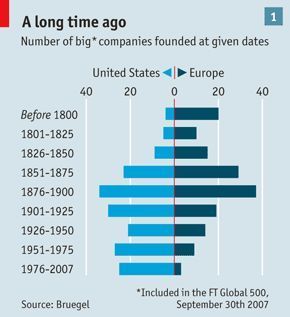
Large companies in US and Europe by date of creation (the Economist)
In this graph extracted from the Economist paper, “les Miserables“, or how Europe consistently discourages entrepreneurs (published July 2012), all the drama of Europe is being shown. The drama of the end of the Industrial Age and of the struggle to take the leap of the Collaborative Age. Europe relies on large companies that have been predominantly founded at the heart of the Industrial Age.
Unfortunately this graph is incomplete. It does not show how Indian, Brazilian and Chinese large companies have appeared in the last two decades and how some prominent companies from those countries are already bigger than most companies from the old developed world. Their contribution would only affect the latest period!
Sticking to the Industrial Age model is not a good idea. Europeans, let’s finally do the leap into the Collaborative Age for the sake of the next generation!

September 4, 2012
Don’t Miss my next Public Speech in Kuala Lumpur on 11th September!
I will be giving a talk on “How to Master Large, Complex Projects: a Different Ball Game“, organized by the Malaysian Chapter of the Project Management Institute.
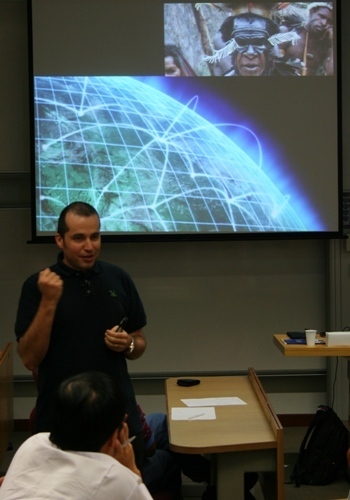
Project Soft Power and the Fourth Revolution
This will happen Tuesday 11 September 2012 from 6:30pm onwards at Bukit Kiara Resort in Kuala Lumpur. Interested? All the details are to be found in the PMIMY flyer for that Speech on Large Complex Projects.
As usual I will seek will interest and entertain you with my dynamic style!
Come to this exclusive opportunity to gain insights into Large, Complex Projects and discover Project Value Delivery’s proven approach to deliver these projects successfully!
Click here for the details to the speech venue and registration. Don’t miss this unique opportunity and maybe even win some of the books published by Fourth Revolution!

September 1, 2012
Openness Alone Cannot Drive Change. It is Just the Beginning.
The title of this post is a quote from one of the most inspiring videos I have seen for a long time. Margaret Heffernan explains how having information available out in the open is not enough for people to notice and take action.
She explains how a scientist investigated the growing number of childhood cancers and had discovered the noxious effects of X-rays of pregnant women on children in the 1950′s – how all this information was published, out in the open – and how the medical establishment took decades to notice and do something about it.
Look at this 12 mins video, it’s worth it!
Here’s the link if you can’t see the video.
I love one of the final quotes of Margaret’s speech: “Open information is fantastic, open networks are essential. But the truth won’t set us free until we develop the skills and the habit and the talent and the moral courage to use it. Openness isn’t the end. It’s the beginning.”
The availability of information thanks to the Fourth Revolution is only the beginning. Leadership is needed to make something out of it, to manage the conflict that open information does provoke.
Hat tip to Tim Berry who talked eloquently about the video on his blog.

August 30, 2012
The consultant dilemma: one man show or team show?
As my business shows success, I am confronting a traditional dilemma: stay as a one-man-show and increase personal profitability through deepening my brand, or rather seek to expand and scale through setting up a team?
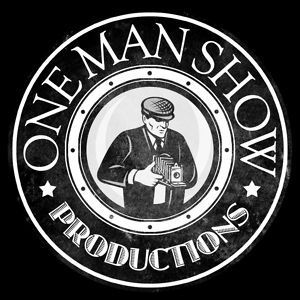
One Man Show or Team Show?
It is true that I could surf on my network and just expand my own expertise into a more and more profitable enterprise. In the short term it could be more profitable. Yet it is not what I am seeking.
Of course the answer to this question is biased in my case because from the beginning I had planned to involve other people. Still, it is true that expanding my company into a team introduces additional complexity. I now fully understand authors such as Alan Weiss that strongly recommend one-man shows for consulting companies and demonstrate through their own example how they can build such a setup to be profitable and eminently controllable.
Yet I find that there is also a lot of fun in developing a company by involving other people and scaling its impact through other contributors. Having people to discuss with, to work with, to confront difficulties with, is an unappreciated value that really changes the life of the entrepreneur. Yes, of course it involves more complexity and time to organize and manage a team. This time and energy is amply rewarded by the insights and the reach that is developed accordingly.
Not to mention that clients expect often consultant shops to be able to show a team with diverse and complementary skills and talents, that are able to tackle more complex and ambitious projects.
Without doubt, I can confirm that the way to go is to develop a team and expand by involving people. The right people of course, that are carefully selected to join the bus. But that’s much more fun than staying as a one-man show. And in the spirit of the Fourth Revolution, everything is in the team!
A first partner has joined and I hope more will come. I’ll share the learning in future posts!

August 28, 2012
Do you Still Think that Curation of Content is a Guarantee of Quality? The Jonah Lehrer Case.
There has been a scandalous affair recently at the New Yorker that has had shaken the web (and more). One of their staff writers had just written a best-selling book about creativity and was forced to resign after he could not demonstrate the origin of some quotes he was attributing to Bob Dylan. He finally admitted that he invented them.
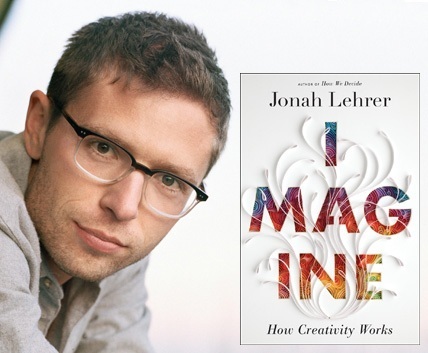
Imagine… a book a bit too imaginative!
Funnily enough the book was about Imagination and Creativity. Don’t look for for it anywhere, it has been removed from all selling channels by the publisher (although more than 100,000 had been sold already).
More about this story if you are interested in this article on Jonah Lehrer’s deceptions (it seems to be written by the original person who uncovered the issue). More comments also in this excellent blog post on How to Resist the Temptation to Lie and Cheat your Way to the Top. There has been a flurry of posts and write-ups on the issue, so if you want even more just google Jonah Lehrer!
This is a good reminder than even the best-run fact checking factories like the New Yorker can fail to identify writers that fake it. The best curated content is not 100% mistake and lie-proof.
The Fourth Revolution brings in the validation from the crowd. And the crowd it is that uncovered that incredible falsification. It is not the first time, it won’t be the last time; but it becomes harder to fake it with the always greater insights of the crowd. This time it took a person passionate about Bob Dylan, knowing all his interviews and quotes, to figure out that something was wrong. It only took a few weeks.
And so will the world increasingly question the content of even the most reputable curators. This constant challenge by people who are extremely knowledgeable in their niche area will create increasingly better content to the world.
Funnily enough I had bought the book – it is on my Kindle – and will now read it knowing that for a book about creativity it must be really good as it is at least partially the result of the imagination of the author!

August 25, 2012
How crowd-opinions are now more powerful than any advertising
The world of advertising is trembling. As the following graph from Nielsen, a market research giant, online conversations and the opinions of other internet users have much more credibility than newspaper articles and any other form of advertisement!
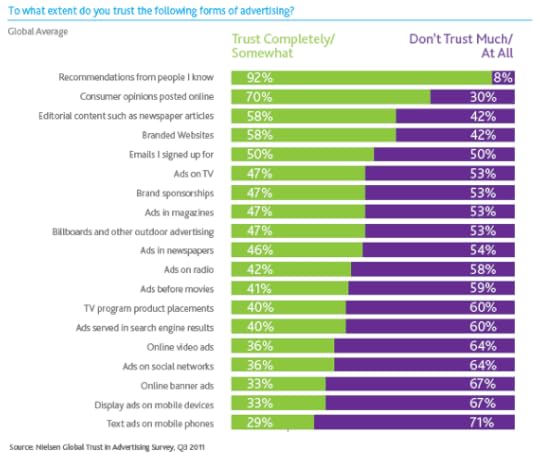
People trust more other people's comments on internet than newspaper articles or other ads
What can we take from this? The power is to the organizations that leverage the user’s opinions on the products by providing the right platform: this relaunched Amazon at the beginning of the 2000′s, and is the fundamental insight of TripAdvisor and many others. It’s a real crowd-sourcing of opinions that people use more and more to decide whether to use/buy the product.
Is it resilient to manipulation? It is certainly more than conventional advertisement. And the most important is to determine how the seller reacts to these opinions and improves his product.
Crowd-opinion is the new credo of trust, like crowd-knowledge is the new baseline of knowledge. It has limits, it can be sometimes dangerous but in a world where we often buy remote products that none of our friends has seen or used, it seems like the best alternative.
What do you think? How much do you rely on crowd-opinions?

August 23, 2012
How more constraints force us to create better solutions
“In the field of design, there is the belief that with more constraints, better solutions are revealed” – John Maeda in “The laws of simplicity”
Would that also be true in real life?
Would more constraints force us to find better solutions because it would force us out of our comfort zone – out of the easy solutions? At what stage are there too many constraints to impede any meaningful creation?

Chapel of the Holy Cross in Sedona (Arizona) – a magnificent example of inspired design in a constrained setting
I certainly do admit that highly constrained situations do force to think creatively and find solutions that are hidden at first. The only condition is to still feel empowered in spite of the apparent obstacles.
How can we continue to feel empowered and inspired when the situations seems immovable? Personally beyond a certain difficulty I often feel more empowered than dis-empowered by the challenge. An other way is to be motivated by the desire to achieve the goal that requires this creation. Your sense of purpose will make you overcome seemingly insurmountable obstacles.
Now – are the solutions created by us or revealed to us? Isn’t it the same at the end?
Yes, certainly more constraints will make us all find better solutions. It’s a challenge, it’s a chance, we need to grab it. Now.

August 21, 2012
Transform uncertainty and fear into fuel for creation
“Creators train themselves to transform uncertainty, fear, and doubt into fuel for creation”
This is a quote from ‘Uncertainty‘, a book by Jonathan Fields, which resonates deeply with me.
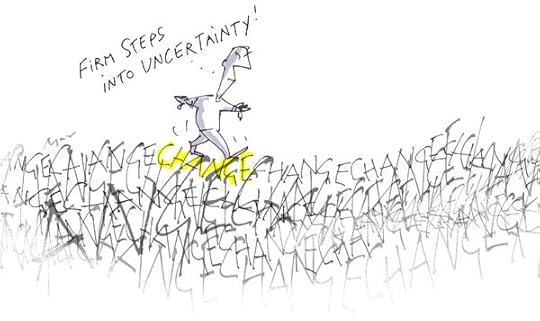
Are you ready to step into uncertainty?
I hate to face uncertainty. I’d like my life to be organized and predictable for the next few months, years.
I hate having a predictable life. Much too boring. So challenging!
I am stressed and fearful sometimes. Quite often actually since I started my own company. Some days it gets the better of me and I avoid the issue. Some days it pushes me forward into action.
So what? I progressively learn to accept uncertainty and fear and how it opens opportunities. I still have a long way to go to welcome, to grab these feelings and use them as a source of energy. Still I am on my way, and there are times where I experience uncertainty or fear as a real fuel for creativity.
See, avoiding uncertainty and fear was the mindset of the Industrial Age. Welcoming uncertainty and fear as a transformational force will be the mindset of the Collaborative Age. We need to learn that because it will be what makes us successful.
And you? I’d like to hear about your experience in the comments!




